On 11 July 2022, Cambridge Zero Director, Prof Emily Shuckburgh, joined the UK government’s chief scientific adviser in giving an emergency climate change briefing to MPs, warning of the dangers of the climate crisis and urging them to act.
Here's the full text of her briefing along with links to sources.
Temperatures are approximately 1.2 degrees Celsius hotter than they were in pre-industrial times.
The impacts of climate change are now being felt in every region of the world.
Further heating of the planet would result in even greater risks to people and to nature, and would threaten catastrophic changes occurring such as the loss of the vast ice sheets covering Greenland and West Antarctica, which equate to many metres of sea level rise.
[Sources: https://public.wmo.int/en/media/press-release/2020-was-one-of-three-warmest-years-record; https://www.ipcc.ch/report/ar6/wg1/]
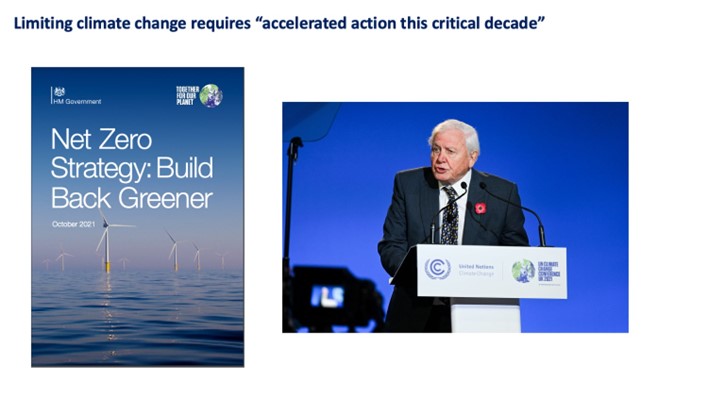
The Glasgow Climate Pact agreed at COP26 recognised that to limit global warming to 1.5 degrees requires almost halving global carbon dioxide emissions by 2030 and reaching net zero around mid-century, as well as deep reductions in other greenhouse gases. It called for accelerated action in this critical decade.
Net zero emissions has become the standard goal throughout the world, but many countries currently have only loose pledges.
The UK stands out with an ambitious target to be net zero by 2050, and a strategy with detailed plans for near term reductions in emissions.
Now is the time for turning ambition into action, it is a time for delivery & implementation, resulting in real-change across society, setting us on a course for a greener, healthier and more resilient future.
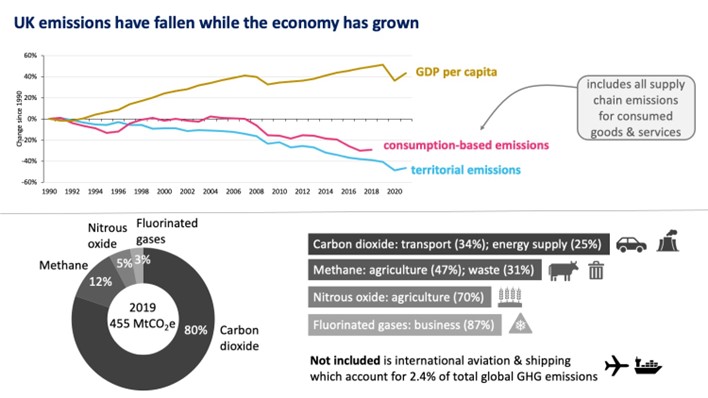
The UK has made considerable progress on the journey to net zero.
Over the last 3 decades, territorial greenhouse gas emissions – those produced within UK borders and well as the UK’s share of emissions from international aviation and shipping have almost halved.
80% of those territorial emissions are in the form of carbon dioxide, but others notably methane, nitrous oxide and fluorinated gases are also significant.
In the next 3 decades, these emissions need to get to net zero.
Consumption emissions, which accounts for relevant emissions produced overseas, have also fallen, although only in the last 10 years.
Crucially, these drops in emissions have occurred while the UK’s economy, as measured by GDP, has continued to grow.
[Territorial emissions data from: https://www.gov.uk/government/statistics/final-uk-greenhouse-gas-emissions-national-statistics-1990-to-2020; International aviation and shipping data from https://report.ipcc.ch/ar6wg3/pdf/IPCC_AR6_WGIII_FinalDraft_FullReport.pdf; Consumption data: https://www.gov.uk/government/statistics/uks-carbon-footprint; Other sources: https://www.theccc.org.uk/publication/2022-progress-report-to-parliament/]
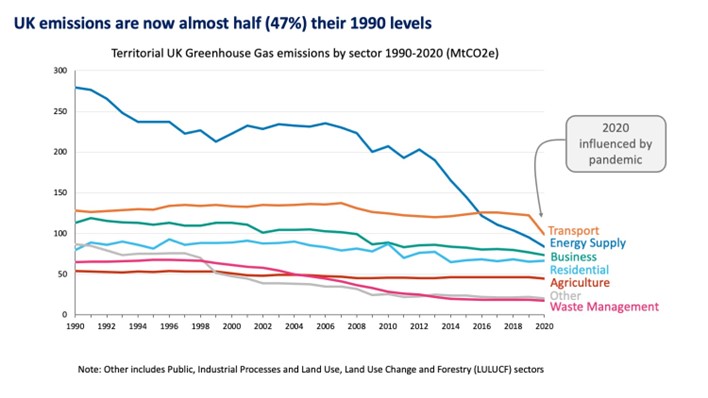
We can see here which sectors have contributed to-date in the UK’s emissions reductions.
Emissions from energy supply are now just 30% of what they were in 1990, primarily as a result of phasing out of coal and developing low carbon sources of electricity such as wind, solar and nuclear.
In 2021 emissions from electricity generation represented 11% of total UK greenhouse gas emissions. This primarily came from gas-fired power stations.
The UK has committed to fully decarbonising electricity generation by 2035 and so further scale-up of renewables is required.
Today the largest emitting sectors are surface transport – mostly cars – and buildings – mostly heating our homes – with significant contributions from other sectors across the economy.
The dramatic drop in emissions in the transport sector in 2020 was entirely due to travel restrictions and guidance due to the covid 19 pandemic.
Aside from that anomaly though, transport and other sectors have seen rather little change in emissions to-date.
[Data from: https://www.gov.uk/government/statistics/final-uk-greenhouse-gas-emissions-national-statistics-1990-to-2020]
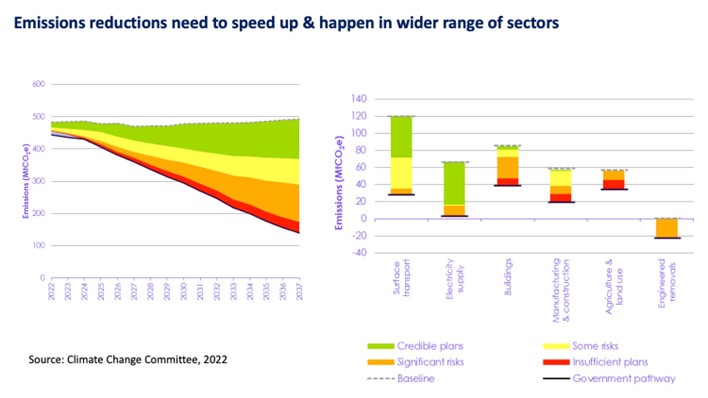
In its recent progress report to parliament, the Climate Change Committee provided an independent assessment of the UK’s plans and gave a mixed picture.
Overall, the committee found that if delivered in full, the plans would provide the required emissions reductions by the mid 2030s.
But they estimated that a quarter of the plans had some associated risk – in yellow, a third had significant risks – in orange and 5% were completely insufficient – in red.
Generally, surface transport and electricity supply were viewed as having credible plans. But significant risks were found associated with almost all other sectors, with particular concerns about the lack of detailed plans for the decarbonisation of homes and of agriculture and land use.
And it noted an opportunity to bolster consumer-led trends in terms of healthier lower-meat diets with policy instruments.
[Source: https://www.theccc.org.uk/publication/2021-progress-report-to-parliament/]
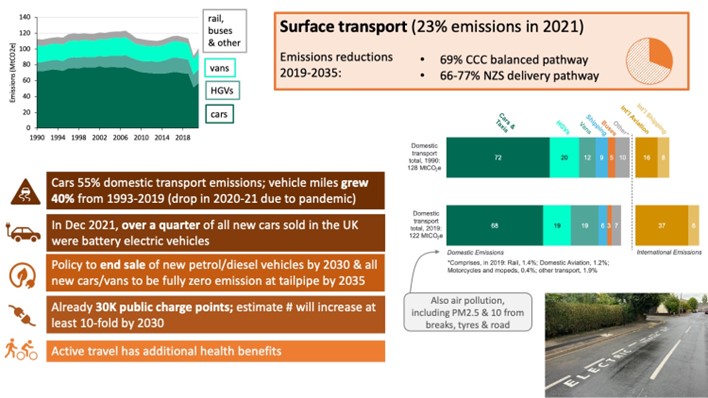
Taking a closer look at surface transport, more than half of emissions are due to domestic cars.
The pre-pandemic flat emissions profile was as a result of trends towards driving larger vehicles and more miles offsetting modest improvements in the efficiency of new cars. However, now the electric vehicle transition is accelerating rapidly.
By December of last year, a quarter of all new cars sold in the UK were battery electric vehicles. Almost all major manufacturers have now committed to focus on EVs, and there are now over 50 models of electric car and ten models of electric van available.
A near-term future without petrol or diesel cars – inconceivable just a few years ago – is now within sight.
The relevant charging infrastructure is being rolled out, but it needs to be scaled up and the uneven geographic coverage needs addressing.
The EV transition needs to be accompanied by a greater emphasis on healthier forms of transport – walking and cycling – and by improved public transport provision.
And the dramatic growth in emissions over the last 3 decades from aviation in particular also needs addressing.
[Data from: https://www.theccc.org.uk/publication/2021-progress-report-to-parliament/; https://www.gov.uk/government/statistics/final-uk-greenhouse-gas-emissions-national-statistics-1990-to-2020; https://roadtraffic.dft.gov.uk/summary; https://www.theccc.org.uk/publication/independent-assessment-the-uks-net-zero-strategy/
Policy: https://www.gov.uk/government/publications/uk-electric-vehicle-infrastructure-strategy]
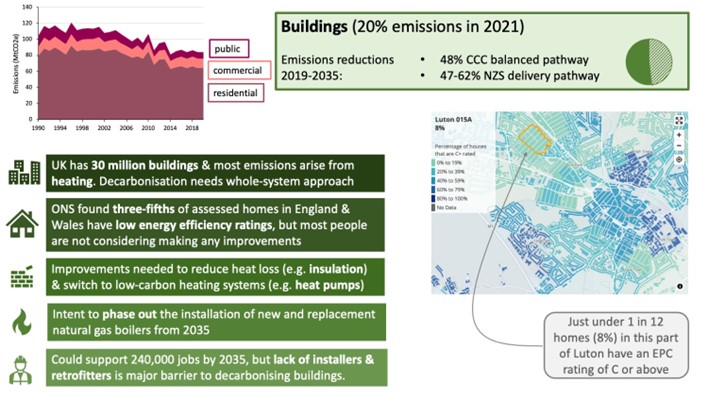
Reducing emissions from buildings – most of which come from burning gas and oil for heating & hot water in homes – is challenging.
Emissions have changed little over the past 8 years, following a dramatic halt in the number of homes receiving energy efficiency improvements when policy changed in 2012.
Three-fifths of homes have low energy efficiency ratings and most people are not considering making any improvements.
At a time of rising energy costs, this is a major missed opportunity to reduce emissions and energy bills. Past experience shows that with the right policies in place, homeowners will improve their insulation.
Installations of heat pumps increased nearly 50% in 2021, but remain very low and need to increase more than tenfold over the next six years to meet targets as the country moves away from gas boilers.
The rapid roll-out of heat pumps, heat networks and energy efficiency retrofits will require skilled workers in construction and other related trades. This is both an opportunity, with an estimated 240 thousand green jobs available in the sector, and a barrier, as lack of trained installers and retrofitters limits progress.
And in an area that has such a clear impact of people’s lives, broad public engagement in policy design and implementation is essential.
[Data from: https://www.gov.uk/government/statistics/final-uk-greenhouse-gas-emissions-national-statistics-1990-to-2020; https://www.theccc.org.uk/publication/independent-assessment-the-uks-net-zero-strategy/
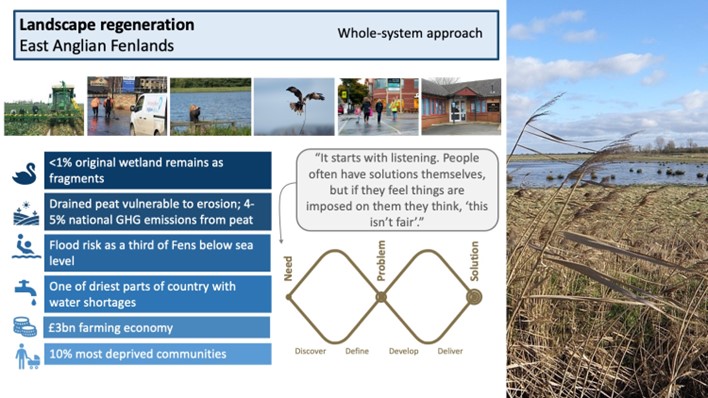
The solutions to many net zero challenges require radical whole-system approaches. Here is an example we are researching at the University of Cambridge: the East Anglian Fens.
This is a region significantly at risk from climate change AND where land management practices can contribute to climate change. But carefully designed landscape regeneration could provide benefits to people, nature and climate.
Drained in the 17th century, less than 1% of the original wetlands remain. The peat provides rich agricultural land, but it is eroding rapidly and contributing significantly to greenhouse gas emissions.
The region is both vulnerable to flooding as much is below sea level, and to water shortages as it is one of the driest parts of the country; both risks are exacerbated by climate change.
But any new approach needs to be designed holistically and in collaboration with those who live and work in the region, helping to support the local economy and to address the severe social challenges of the region.
A citizens’ jury we helped co-ordinate emphasised the importance of listening, and of ensuring solutions are fair to all.
[Information sources: https://www.fensforthefuture.org.uk/challenges/; https://www.nfuonline.com/regions/east-anglia/; https://www.gov.uk/government/collections/english-indices-of-deprivation
University of Cambridge’s Centre for Landscape Regeneration: https://www.clr.conservation.cam.ac.uk/
Citizens’ Jury reported in Cambridgeshire and Peterborough Independent Commission on Climate report: https://cambridgeshirepeterborough-ca-gov-uk-6985942.hs-sites.com/cpicc-initial-report]
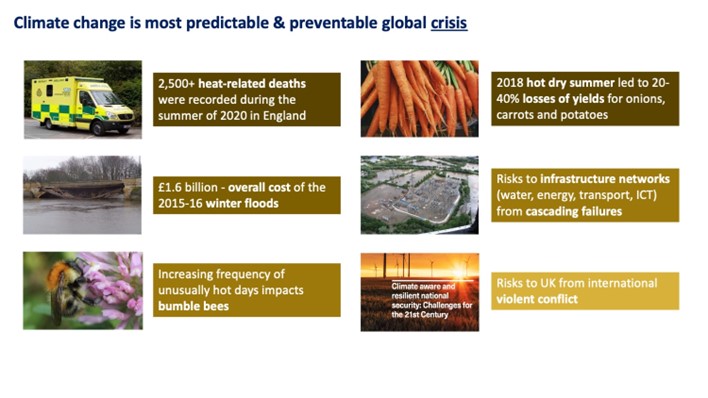
So where does that leave us? In the context of a global pandemic and the globally reverberating implications of the Russian invasion of Ukraine in terms of the cost of living, climate change is the most predictable and also the most preventable global crisis.
In the UK we are already experiencing the economic and human costs of extreme heat and flooding – with the climate-related risks, for example, of cascading failures of critical infrastructure only just starting to be properly understood.
Our natural world, already under pressure, is threatened further.
And in a globally interconnected world, the risks posed by climate change fuelling the underlying causes of migration and violent conflict and are clear.
There are risks too from climate change or ill-conceived responses to it exacerbating social inequality or from a climate-induced redrawing of the geopolitical map.
[Sources: https://assets.publishing.service.gov.uk/government/uploads/system/uploads/attachment_data/file/1047003/climate-change-risk-assessment-2022.pdf; https://www.theccc.org.uk/publication/independent-assessment-of-uk-climate-risk/; https://www.science.org/doi/10.1126/science.aax8591; https://www.turing.ac.uk/research/publications/climate-aware-and-resilient-national-security-challenges-21st-century]
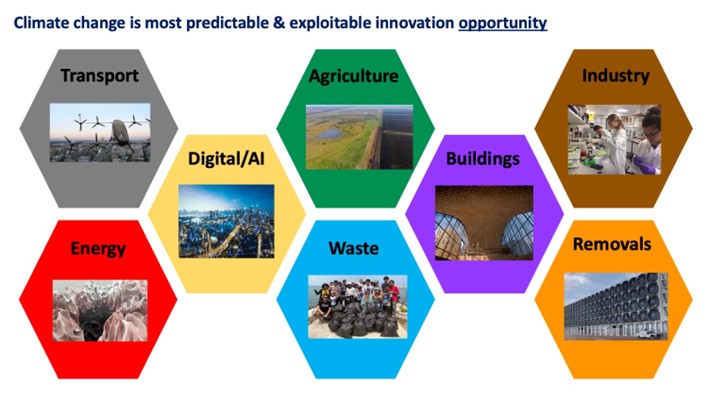
But where there are risks, there are also opportunities.
Climate change can equally be seen as the most predictable and exploitable innovation opportunity.
Capitalising on the long tradition of creativity and ingenuity, and a strong knowledge economy, the UK is in a powerful position to lead the way and gain a competitive advantage from the transition.
Whether in terms of new battery technologies, net zero aviation, the application of AI and digital technologies, sustainable agriculture, supporting a circular economy, development of new green construction materials or green industrial processes, or natural and engineering approaches to greenhouse gas removal, opportunities abound.
An exciting, greener, cleaner, healthier and more prosperous future awaits us if we chose to embrace it.
[Sources: https://www.zero.cam.ac.uk/green-recovery-report]



